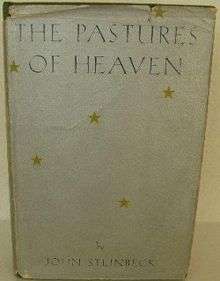The Pastures of Heaven

(publ. Brewer, Warren & Putnam)
The Pastures of Heaven is a short story cycle by John Steinbeck, first published in 1932, consisting of twelve interconnected stories about a valley, the Corral de Tierra, in Monterey, California, which was discovered by a Spanish corporal while chasing runaway Indian slaves. Enchanted by the valley's natural beauty, the corporal names it Las Pasturas del Cielo or "The Pastures of Heaven." The stories are written in classic Steinbeck style; the lives of the families that relocate to the valley are portrayed with a mixture of humor and poignance. A recurring theme in the book is the pain caused when people try ineptly to help or to please others.
In the arts
In the story "Junius Maltby", one of the characters regards Robert Louis Stevenson's Travels with a Donkey in the Cevennes as one of the greatest works of English literature and eventually names his infant son Robert Louis. Steinbeck was later inspired by Stevenson in choosing to title his account of his cross-country voyage with a gray-haired poodle in the 1960s, Travels With Charley: In Search of America.
Legacy
The grounds of the schoolhouse in which many chapters are set is still in use by the Washington Union School District where fourth and fifth grade are taught.
Adaptations
A stage adaptation of The Pastures of Heaven done as a collaboration between the California Shakespeare Theater and Word for Word Performing Art Company (a company that stages short stories literally word for word) premiered in Orinda, California, in June 2010. The script was by Octavio Solis, and it was directed by California Shakespeare Theater's artistic director Jonathan Moscone.
References
Further reading
- Martock, Melanie. "The Eden Myth as Paradox: An Allegorical Reading of Pastures of Heaven." Steinbeck Quarterly 11.01 (Winter 1978): 6-15.
- Hearle, Kevin. "The Pastures of Contested Pastoral Discourse." Steinbeck Quarterly 26.01-02 (Winter/Spring 1993): 38-45.
- Winn, Harbour. "The Unity of Steinbeck's Pastures Community." Steinbeck Quarterly 22.03-04 (Summer/Fall 1989): 91-103.